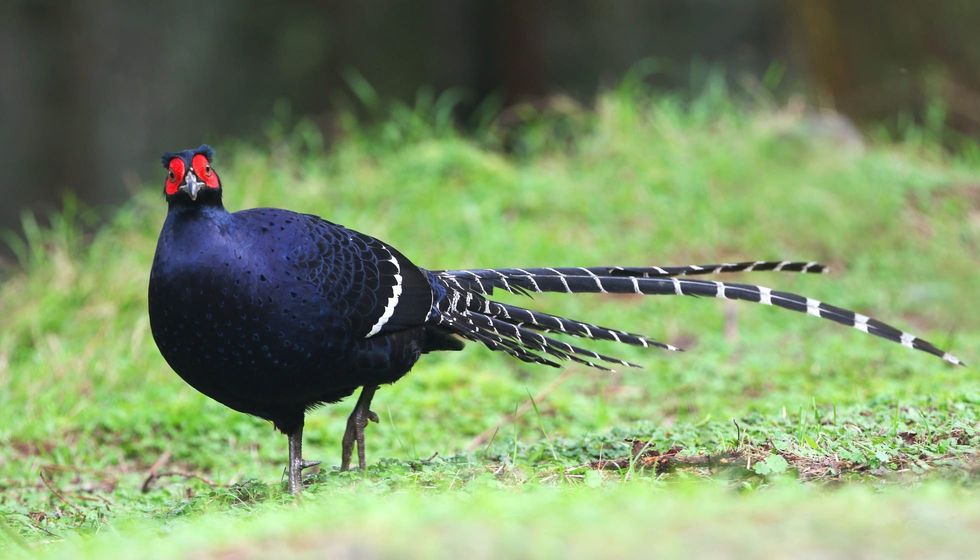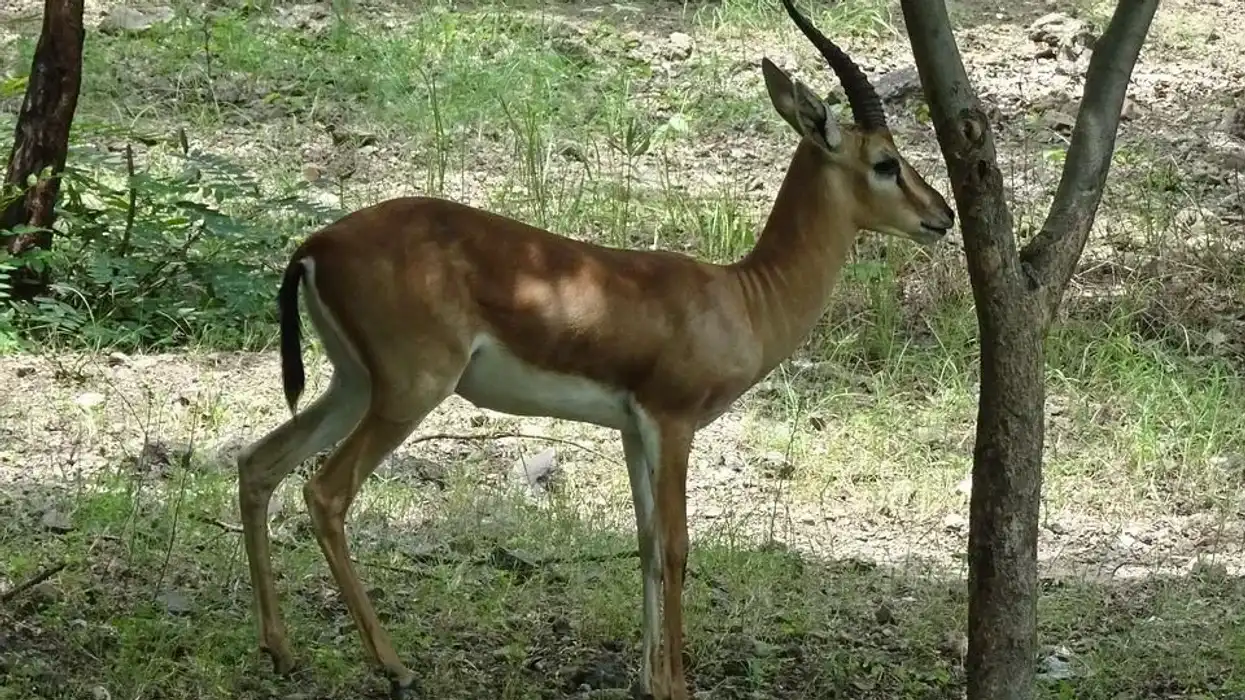The Mikado pheasant (scientifically known as Syrmaticus mikado) is a pheasant bird endemic to Taiwan. Featured on the country's $1,000 bill of the Taiwanese dollar, it is considered the unofficial national bird of Taiwan.
This wild bird from the pheasant family Phasianidae can be found in the mountain regions of central and southern Taiwan occupying forests with dense shrubs and grassy terrain. The genders within this species differ in both color and size.
The adult male species measure an average of 27.5 in (70 cm) with the adult females significantly smaller, measuring an average of 18.5 in (47 cm). The male species has a dark plumage with blue and purple iridescence, a long black tail with white stripes, and red orbital wattles .
Adult females are lighter in appearance, with brown plumage and brown and white quills. This bird is also known as the 'Emperor's Pheasant'.
If you enjoy reading this article, check out these pheasant facts and golden pheasant facts for more
Mikado Pheasant Interesting Facts
What type of animal is a Mikado pheasant?
The Mikado pheasant is a bird.
What class of animal does a Mikado pheasant belong to?
The Mikado pheasant belongs to the Aves class of the warm-blooded vertebrate birds.
They are also characterized by unique features including their feathers, toothless beaked jaws, and laying of hard-shelled eggs. They are from the order Galliformes of heavy-bodied ground-feeders and the genus Syrmaticus which contains five species of long-tailed pheasants found throughout Asia.
Aside from the Mikado pheasant found in Taiwan, it also includes the Reeve's pheasant (Syrmaticus reevesii) found in China, the copper pheasant (Syrmaticus soemmerringii) found in Japan, Elliot's pheasant (Syrmaticus humiae) found in South-eastern China, and Mrs. Hume's pheasant (Syrmaticus humiae) found within Burma, China, India, and Thailand.
How many Mikado pheasants are there in the world?
Although bred in captivity, the exact population size of wild Mikado pheasants (Syrmaticus mikado) throughout Taiwan is believed to be about 10,000.
Where does a Mikado pheasant live?
The Mikado pheasant is native to the mountain ranges of central and southern Taiwan. They prefer dense fog and often inhabit mountains with altitudes between 5906-10827 ft (1800-3,300 m) above sea level. This species frequently occupies dense shrubs, bamboo growth, and grassy terrain.
What is a Mikado pheasant's habitat?
The Emperor's pheasant lives in the open shrubbery, found in mixed broadleaf and coniferous forests in Taiwan. With high altitudes above sea level, these cloud forests are usually covered in dense fog. Often called 'King of the Mist' they usually come out on days just after the rain, where they are concealed by the heavy forest fog.
Who do Mikado pheasants live with?
Mikado pheasants may be seen in solitary, in pairs, or small family units (hen with its young). The male species is highly territorial and will fight for their mate or territory.
How long does a Mikado pheasant live?
The average lifespan for a wild Mikado pheasant is 8-10 years.
How do they reproduce?
The breeding season for Mikado pheasants (Syrmaticus mikado) commences from March through to June. A pair will search for natural forest debris to construct their nests, which may include fallen leaves, dead branches, dry grass, and feathers.
Hens will lay between three to eight eggs which they will also incubate (usually 26-28 days to hatch). Once born, the pair will care for and nurture the young fledglings which are usually independent within six months.
What is their conservation status?
The Emperor's pheasant has previously come close to extinction. Considerable and conscious efforts of conservation workers have since returned this endemic species to more stable population levels.
Within Yushan National Park, this bird is protected and has seen 100% growth in the last 34 years, from a mere 5,000 in 1986 to over 10,000 birds in 2020. Today, the Mikado pheasant is listed as a Near Threatened species.
Although they do not qualify as threatened, they are close and may be considered threatened with extinction in the near future.
Mikado Pheasant Fun Facts
What do Mikado pheasants look like?
The Mikado pheasant is considered the unofficial national bird of Taiwan, this elegant and fascinating bird species has a different plumage depending on sex.
The majestic male species has a shimmering dark blue-black and purple plumage with bright red face wattles, gray feet, and long black tails with white horizontal lines. Adult females are slightly smaller with a less showy plumage of olive-brown and light vertical specks.
Their eyes are surrounded by red skin, with dark brown feathers with orange horizontal bars and their chestnut brown tail feathers have black horizontal bars.
How cute are they?
This elegant and mysterious bird is quite enchanting. The male species has a very beautiful shimmering and iridescent plumage. Although the females are not as vibrant, they have a fascinating olive-brown plumage. Due to their exquisite beauty, it would be more appropriate to call this exotic creature beautiful rather than cute.
How do they communicate?
Although always alert, they are generally quiet. During breeding season, males will often drum their wings and release shrill whistling calls when fighting for their mate or territory, they will make a distinct 'ke, ke, ke' call. They communicate mostly through oral vocalizations and visual signals (body language).
How big is a Mikado pheasant?
The average adult male measures 18.5-27.5 in (47-70 cm) and weighs an average of 1.3-2.6 lb (600-1200 g).
By comparison to the tallest and heaviest bird on earth, adult males are less than one nighty seventh of an ostrich, and just over double the size of other pheasants (family Phasianidae) including the golden pheasant and the Palawan peacock-pheasant (both weighing 1.2 lb (550 g)).
How fast can a Mikado pheasant fly?
The family Phasianidae and order Galliformes are ground-feeders, so they can fly fast but only for short distances. When chased, their strong wings can fly up to 60 mph (97 kph). However, they often prefer to run getting to speeds of up to 10 mph (16 kph).
How much does a Mikado pheasant weigh?
The weight of this bird varies from male to female. The average male bird weighs 1.9-2.6 lb (0.9-1.2 kg) whilst females weigh an average of 1.3-2.2 lb (0.6-1 kg).
What are the male and female names of the species?
Te male and female species are simply referred to as female and male Mikado pheasants.
What would you call a baby Mikado pheasant?
A baby bird in this species is called a fledgling or young Mikado pheasant.
What do they eat?
As they are from the order Galliformes (of ground-feeders), these birds will walk and forage for food on forest floors and mountain trails, similar to chickens. Their diet includes various fruit, leaves, vegetation, seeds, and invertebrates (insects).
In captivity, they will consume a range of fruits and vegetables including lettuce, berries, and tomato. Wild predators (particularly during nesting) include Corvids (mainly carrion crows) and foxes.
Are they dangerous?
These birds can tolerate the presence of humans, particularly in areas where they have become accustomed to being fed by them. Male birds can be territorial with a range of 656-1,312 ft (200-400 m).
Would they make a good pet?
Mikado pheasants are successfully bred in captivity. Although breeding them is significantly more difficult than domestic birds, once bred and given suitable habitat, they are great pets as they are quiet and easily tamed.
For these birds, the aviary size of 200 sq ft (18.6 sq m) is best with lots of brush and bushes so they are free to walk around. As pets, their vegetation diet can be supplemented with a range of normal fresh fruits and vegetables including lettuce, berries, and tomatoes.
Did you know...
Although the five different species of pheasants within the genus Syrmaticus have a range of different plumage colors, they all have long tails, short spurs on their legs, and face wattles in common. Eggs of Mikado hens are also almost twice the size of other birds in their genus.
Are Mikado pheasants Endangered?
Humans are their biggest predators, who have hunted them for their meat and feathers. In the 20th century, their population declined significantly from hunting and habitat (forest) degradation.
However, since 1986, conservation efforts have seen populations of this protected species increase by 100% in the Yushan National Park. Although the population today has increased significantly, they are still considered as Near Threatened and their long-term survival remains at-risk.
How did Mikado pheasants get their name?
According to the Administration office of the Yushan National Park, when British Ornithologist Walter Goodfellow traveled to Yushan, Taiwan to collect specimens, they discovered a pair of feathers on the headdress of a Tsou Aborigine. Once identified as a new species, Scottish ornithologist William Robert Ogilvie Grant (1906) named this species the Mikado pheasant, 'mikado' meaning Japanese emperor.
This is why it is also known as the 'Emperor's Pheasant'.
Here at Kidadl, we have carefully created lots of interesting family-friendly animal facts for everyone to discover! For more relatable content, check out these partridge facts and common blackbird facts pages.
You can even occupy yourself at home by drawing one on our free printable pheasant coloring pages.










